TUTTLE Pocket Thai Dictionary Thai-English
English-Thai Jintana Rattanakhemakorn  Published by Tuttle Publishing, an imprint of Periplus Editions (HK) Ltd. www.tuttlepublishing.com Copyright 2020 by Periplus Editions (HK) Ltd All rights reserved. No part of this publication may be reproduced or utilized in any form or by any means, electronic or mechanical, including photocopying, recording, or by any information storage and retrieval system, without prior written permission from the publisher. ISBN 978-1-4629-2165-2 Distributed by: North America, Latin America and Europe Tuttle Publishing 364 Innovation Drive, North Clarendon, VT 05759-9436 USA Tel: 1(802) 773-8930 Fax: 1(802) 773-6993 www.tuttlepublishing.com Asia Pacific Berkeley Books Pte. Ltd. INTRODUCTION Thai is the official language of Thailand. INTRODUCTION Thai is the official language of Thailand.
Published by Tuttle Publishing, an imprint of Periplus Editions (HK) Ltd. www.tuttlepublishing.com Copyright 2020 by Periplus Editions (HK) Ltd All rights reserved. No part of this publication may be reproduced or utilized in any form or by any means, electronic or mechanical, including photocopying, recording, or by any information storage and retrieval system, without prior written permission from the publisher. ISBN 978-1-4629-2165-2 Distributed by: North America, Latin America and Europe Tuttle Publishing 364 Innovation Drive, North Clarendon, VT 05759-9436 USA Tel: 1(802) 773-8930 Fax: 1(802) 773-6993 www.tuttlepublishing.com Asia Pacific Berkeley Books Pte. Ltd. INTRODUCTION Thai is the official language of Thailand. INTRODUCTION Thai is the official language of Thailand.
It is the medium of instruction in schools, of the media and in all government affairs. Thailand has a population of over 60 million. Perhaps an estimated 80% of the population speaks standard Thai, also known as Central Thai, as their first language. In addition, the latest (2015) statistics shows that approximately 40 million people worldwide speak Thai as a second language. This Pocket Thai Dictionary provides standard Thai with both colloquial and formal entries. It also includes various idioms, slang terms, and the most commonly used Thai words.
To help the user get a better sense of how different Thai words function, there are also a number of specific examples of usage provided. At the same time there are also loanwords taken from English language, especially many related to technology, innovation, and social media. In order for the user to understand Thai before using this dictionary, a pronunciation guide and other important pointers for the language are also provided. Thai is straightforward for beginners, and the basic structure is considerably simple when compared to some European languages, for example: Nouns do not have plural forms or gender. Verbs are not conjugated for tenses, plurals, or genders. Articles such as a, an, or the are also not used.
Tenses are indicated with simple time words. No punctuation is used to indicate a question or the end of a Thai sentence. Basic sentence structure is subject-verb-object as in English. Sound System and Pronunciation Guide Thai is a tonal language with 5 tones, meaning that each word has a certain pitch characteristic with a different, unrelated meaning. Thai doesnt use an alphabetical writing system like in English. Consonants There are 21 initial consonant sounds. Consonants There are 21 initial consonant sounds.
They are listed in the table below with examples of how they are pronounced in English.
| Romanized letters | Sounds like | as in |
| k | g | s ki p |
| kh | k | k id |
| ng | ng | si ng ing |
| j | j | j ail |
| ch | ch | ch ill |
| s | s | s it |
| y | y | y ou |
| d | d | d ate |
| t | t | s t ep |
| th | t | t own |
| n | n | n ot |
| b | b | b ank |
| p | p | s p y |
| ph | p | p oll |
| f | f | f an |
| m | m | m ean |
| r | r | r ow |
| l | l | l ike |
| w | w | w ell |
| h | h | h at |
| o | o | o wn |
Note: There are some aspirated consonants (with an h after the consonant sound) that are slightly difficult for the learners as they are unaspirated (meaning that there is no accompanying puff of air). For example, the
th and
ph sounds are not pronounced as in Englishthey are pronounced as t and p but with a slight puff of air after the consonant. Therefore, when pronouncing the word Thailand, the actual pronunciation is closer to Tie-land and not Thigh-land.
Ending consonants There are eight ending sounds at the end of a syllable.
| Ending consonants | Sounds like | as in English |
| k | k/g | pic k /hu g |
| t | d/t | lou d /hit |
| p | b/p | lo b /ca p |
| ng | ng | wro ng |
| n | n | ca n |
| m | m | di m |
| y | y | bu y |
| w | w | lo w |
Consonant Clusters There are 11 consonant cluster sounds in Thai which are cluster with r, l and w sounds.
| Ending consonants | Sounds like | as in English |
| k | k/g | pic k /hu g |
| t | d/t | lou d /hit |
| p | b/p | lo b /ca p |
| ng | ng | wro ng |
| n | n | ca n |
| m | m | di m |
| y | y | bu y |
| w | w | lo w |
Consonant Clusters There are 11 consonant cluster sounds in Thai which are cluster with r, l and w sounds.
They are as follows: gr, gl, gw, khr, khl, khw, tr, pr, pl, phr, phl. In formal situations r and l are usually pronounced quite clearly and distinctly. However, both are often used interchangeably in Thai or sometime can be dropped or omitted particularly in everyday casual talk. For example:
| Formal speech | Informal speech |
| khrwp-khrua (family) | khwp-khua |
| phr (monk) | ph |
| klai (far) | kai |
| rian (to study) | lian |
Most Thais cannot properly say l and r especially in some parts of the country, like the North and North-East, where their dialects replaced
r by
h .
Vowels Thai vowels are generally separated into short and long forms. The term long and short refers to the duration that the vowel is pronounced. You need to use a correct one, otherwise it can change the meaning of the word.
For example, t (short vowel) means to criticize, whereas tii (long vowel) means to hit. 1. Short vowels
| Vowel sound | Sounds like |
| a | a as in h u t |
| i | i as in k i d |
| u | u as in s ui t |
| e | e as in l e t (shorter) |
| o | o as in o h! (shorter) |
2. Long vowels
Next page
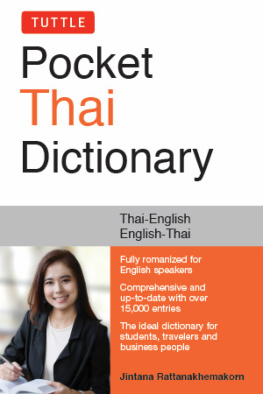
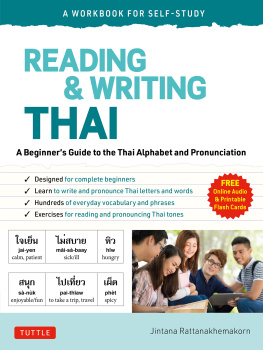
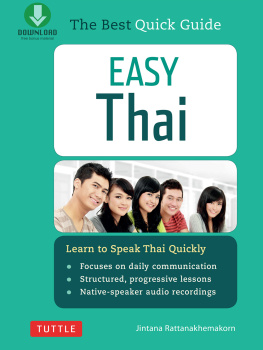
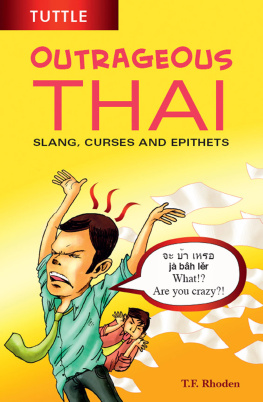
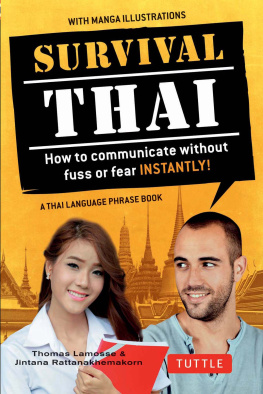
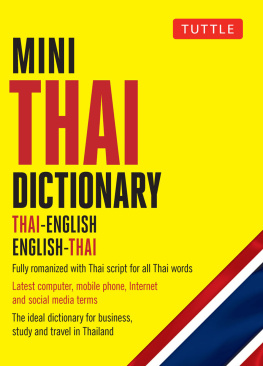

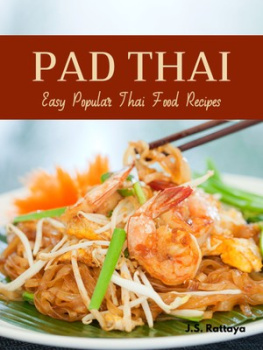


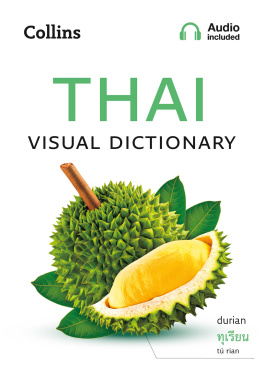


 Published by Tuttle Publishing, an imprint of Periplus Editions (HK) Ltd. www.tuttlepublishing.com Copyright 2020 by Periplus Editions (HK) Ltd All rights reserved. No part of this publication may be reproduced or utilized in any form or by any means, electronic or mechanical, including photocopying, recording, or by any information storage and retrieval system, without prior written permission from the publisher. ISBN 978-1-4629-2165-2 Distributed by: North America, Latin America and Europe Tuttle Publishing 364 Innovation Drive, North Clarendon, VT 05759-9436 USA Tel: 1(802) 773-8930 Fax: 1(802) 773-6993 www.tuttlepublishing.com Asia Pacific Berkeley Books Pte. Ltd. INTRODUCTION Thai is the official language of Thailand. INTRODUCTION Thai is the official language of Thailand.
Published by Tuttle Publishing, an imprint of Periplus Editions (HK) Ltd. www.tuttlepublishing.com Copyright 2020 by Periplus Editions (HK) Ltd All rights reserved. No part of this publication may be reproduced or utilized in any form or by any means, electronic or mechanical, including photocopying, recording, or by any information storage and retrieval system, without prior written permission from the publisher. ISBN 978-1-4629-2165-2 Distributed by: North America, Latin America and Europe Tuttle Publishing 364 Innovation Drive, North Clarendon, VT 05759-9436 USA Tel: 1(802) 773-8930 Fax: 1(802) 773-6993 www.tuttlepublishing.com Asia Pacific Berkeley Books Pte. Ltd. INTRODUCTION Thai is the official language of Thailand. INTRODUCTION Thai is the official language of Thailand.